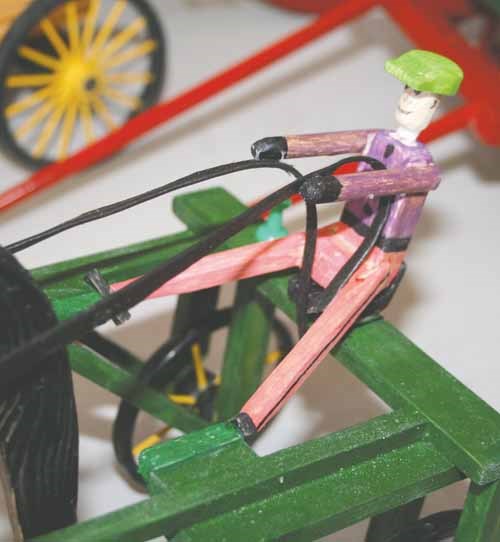When Lloyd Miller (Jr.) bought his father a wooden covered-wagon at a yard sale, he did not know it would launch his namesake into a new hobby.
"He's the instigator," said Lloyd Miller (Sr.), having pointed to the covered wagon on a shelf in the kitchen of his Rhein, SK. home. "That's what got me started."
The covered wagon was inspiration for Miller to start constructing horse-drawn conveyances and equipment, all out of wood.
Miller, 78, said as far as working with wood, it came naturally.
"All my life I'm a carpenter, a finishing carpenter," he said, pointing to his home where the interior is being converted to wood.
"I got tired of looking at Gyproc, so I'm doing everything in wood," he said.
But the interior conversion has been put on hold a little as Miller had taken to making showpiece models.
"A hay rack was the first one I did," he offered, adding that first piece was made around Christmas time (2013).
"After that I didn't know when to stop," he said with a smile. "I'm still going."
In the ensuing eight-to-10 weeks Miller has become a prolific creator of wooden pieces. The collection already has 10 detailed pieces, most with an accompanying wall mount allowing them to be prominently displayed in his home.
While Miller has saws in the basement, the bulk of the work on his pieces is carried out at the kitchen table.
"Right here," he said touching the table top. "This is where I do everything."
Miller said the key is having a plan for a new piece.
"I draw all my plans first, and go from there," he said. I draw a plan and then I build it."
The key for Miller is detail.
The stagecoach has hand made luggage pieces on the top, small detailed lamps on the side, a door that opens, and even a rifle for the driver.
Miller does use toy horses for his pieces, adding that having them ahead of creating a piece is imperative.
"You need the team of horses to build it (the piece) to scale," with the animals, he explained.
Working with the toy horses has been a challenge of its own. It has meant having to create bridles and halters and then the harness to connect the animals to the pieces.
"I'm not a farmer," he said, adding as a result he never had much to do with work horses, or their harness. "I had to learn how to make a harness. I asked people how to do it," he noted, pointing out the leather came from an old coat.
Miller also takes pride in not using nails. He said he'd offer a magnifying glass to anyone to go over his pieces.
"If you find one nail I'll pay you for it," he said as a boast of pride. "There's not a nail in anything. Everything is glued."
Miller noted the pieces are artisan craft work and as a result are showpieces.
"They're not toys to play with," he said.
In creating such intricate pieces, Miller said there have been challenges.
One was how to build spoked wheels for a stagecoach.
"I tried everything," he said with a smile, finally coming up with the solution of using round toothpicks as the spokes, and thin slices of sewer piping as the outer wheel.
There has also been a learning curve in terms of exactly what old horse-drawn machines looked like.
In the case of a hayrack, Miller had seen them first hand in the past, so that helped.
"I knew how they were built," he said.
But other items he was not familiar with.
"You don't see that many stagecoaches in this area. I don't think they were ever used here," he said.
The Internet has helped. Miller has downloaded pictures of various things he wants to build. But even the Internet is not a complete resource. He said it is great for pictures from manufacturing companies of the past, but added in the case of hay racks, the sleighs were usually purchased, but the rack were almost always just built by the farmer, so resource photographs are harder to find.
The pieces are for his enjoyment, and those of visitors.
"I'm not selling them," he said, then added, "unless someone really wanted something, maybe I can build one, but really I'm not looking to sell them."
Miller added he could never sell pieces for what his labour suggests they are worth. The stagecoach, one of his most intricate creations took some two weeks of work.
"It takes so much time I'd have to ask a $1000," he said.
Although as a hobby, Miller said he never worries about time.
"Time is no problem. I can do this from morning until late at night." he said.
While the spaces on walls are filling, Miller has a binder filled with ideas for future pieces.
"I'm just going to keep making them," he said, pointing to the picture of a John Deere grain wagon as his next effort.



